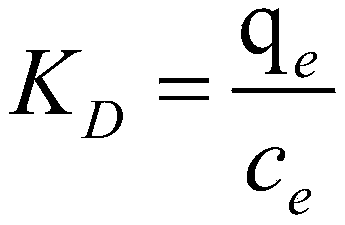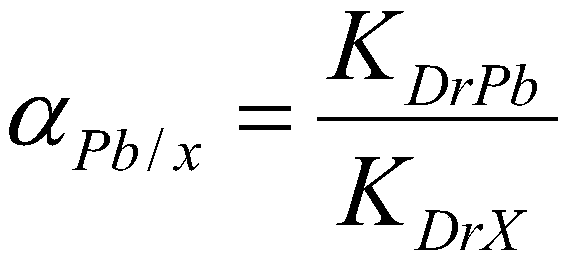Chitosan-based lead ion imprinted adsorbent and preparation method thereof
A technology of imprinting adsorption and chitosan, applied in chemical instruments and methods, adsorption water/sewage treatment, other chemical processes, etc., can solve the problems of difficult separation of target metal ions, reduced CS adsorption capacity, lack of selectivity, etc. Achieve good adsorption and selectivity, improve stability, increase adsorption capacity and selectivity
- Summary
- Abstract
- Description
- Claims
- Application Information
AI Technical Summary
Problems solved by technology
Method used
Image
Examples
Embodiment 1
[0029] (1) Add 1.0g CS and 0.75g EDTA-2Na into 40mL 0.1M HCl solution, and magnetically stir until completely dissolved without bubbles to obtain a mixed solution;
[0030] (2) Use 1M NaOH solution to adjust the pH of the mixed solution in step (1) to 5.5, stir magnetically for 2 hours, dissolve 0.386g EDC·HCl in 10mL deionized water, add it to the mixed solution in an ice bath, and stir vigorously to make it Quickly mix evenly, ultrasonically degas for 10 minutes, and stand at 30°C for 10 hours to obtain EDTA-CS gel;
[0031] (3) Cut the EDTA-CS gel obtained in step (2) into 2×2×2mm pieces, disperse them in 50mL deionized water, add 300mg Pb 2+ , soaked for 4h, and then placed in 100mL 1.5wt% glutaraldehyde solution to cross-link the blot to obtain Pb 2+ Blot EDTA-CS gel;
[0032] (4) the Pb obtained in step (3)2+ Blot EDTA-CS gel in 50mL 0.5mol / L HCl, shake at 30°C for 30min to elute Pb 2+ , repeat the elution 6 times to remove imprinted Pb 2+ , and then washed with deio...
Embodiment 2
[0043] (1) Add 1.0g CS and 0.5g EDTA-2Na into 40mL 0.1M HCl solution, and magnetically stir until completely dissolved without bubbles to obtain a mixed solution;
[0044] (2) Use 1M NaOH solution to adjust the pH of the mixed solution in step (1) to 5.5, stir magnetically for 2 hours, dissolve 0.2575g EDC·HCl in 10mL deionized water, add it to the mixed solution in an ice bath, and stir vigorously to make it Quickly mix evenly, ultrasonically degas for 10 minutes, and stand at 30°C for 10 hours to obtain EDTA-CS gel;
[0045] (3) Cut the EDTA-CS gel obtained in step (2) into 2×2×2mm pieces, disperse them in 50mL deionized water, add 100mg Pb 2+ , soaked for 4h, and then placed in 100mL 0.5wt% glutaraldehyde solution to cross-link the blot to obtain Pb 2+ Blot EDTA-CS gel;
[0046] (4) the Pb obtained in step (3) 2+ Blot EDTA-CS gel in 50mL 0.5mol / L HCl, shake at 30°C for 30min to elute Pb 2+ , repeat the elution 6 times to remove imprinted Pb 2+ , and then washed with de...
Embodiment 3
[0048] (1) Add 1.0g CS and 1.0g EDTA-2Na into 40mL 0.1M HCl solution, and magnetically stir until completely dissolved without bubbles to obtain a mixed solution;
[0049] (2) Use 1M NaOH solution to adjust the pH of the mixed solution in step (1) to 5.5, stir magnetically for 2 hours, dissolve 0.2575g EDC·HCl in 10mL deionized water, add it to the mixed solution in an ice bath, and stir vigorously to make it Quickly mix evenly, ultrasonically degas for 10 minutes, and stand at 30°C for 10 hours to obtain EDTA-CS gel;
[0050] (3) Cut the EDTA-CS gel obtained in step (2) into 2×2×2mm pieces, disperse them in 50mL deionized water, add 200mg Pb 2+ , soaked for 4h, and then placed in 100mL 1.0wt% glutaraldehyde solution to cross-link the blot to obtain Pb 2+ Blot EDTA-CS gel;
[0051] (4) the Pb obtained in step (3) 2+ Blot EDTA-CS gel in 50mL 0.5mol / L HCl, shake at 30°C for 30min to elute Pb 2+ , repeat the elution 6 times to remove imprinted Pb 2+ , and then washed with de...
PUM
 Login to View More
Login to View More Abstract
Description
Claims
Application Information
 Login to View More
Login to View More - R&D
- Intellectual Property
- Life Sciences
- Materials
- Tech Scout
- Unparalleled Data Quality
- Higher Quality Content
- 60% Fewer Hallucinations
Browse by: Latest US Patents, China's latest patents, Technical Efficacy Thesaurus, Application Domain, Technology Topic, Popular Technical Reports.
© 2025 PatSnap. All rights reserved.Legal|Privacy policy|Modern Slavery Act Transparency Statement|Sitemap|About US| Contact US: help@patsnap.com



